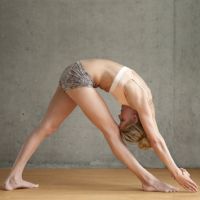Standing Separate-Leg Head-to-Knee Pose
The Standing Separate-Leg Head-to-Knee Pose is the 10th of the 26 Bikram Yoga Asanas. It immediately follows the Triangle Pose and precedes the Tree Pose.
Its original name is the fancy Dandayamana Bibhaktapada Janushirasana.
How To Perform The Standing Separate-Leg Head-to-Knee Pose
Even though the pose may seem simple, it requires a considerable amount of flexibility to perform properly. Follow this step by step guide exactly as outlined.
- Stand with both feet next to each other and lift your arms above your head and point them towards the ceiling. Keep your palms open and flush against each other, while crossing your thumbs. Elbows should remain completely locked.
- While keeping your arms in the previously described position, take a big side-way step with your right leg – a distance of 4-5 feet is ideal.
- Lift your toes off the ground and pivot your entire body on your heels 90 degrees to the right, so that your right leg is now positioned in front of the left leg rather than next to it. Move your hips around a bit left and right to get a nice mild stretch in the area.
- Suck in your stomach while simultaneously tucking in your chin, and begin to move your torso downwards while keeping your legs firmly on the ground; try not to bend the knees, although a very slight bend is acceptable.
- Keep descending with your torso with your arms now pointing downwards (as seen in the picture above), until your fingers touch the ground right in front of your foot, and until your forehead touches your knee. That last part will not be easy to achieve for a beginner, so just attempt to bend down as far as possible – you’ll get it perfectly with time.
- Hold the position for as long as you want or as long as your instructor specifies, then go back up, pivot on your heels 180 degrees to the left, and repeat the above steps for the other leg.

Standing Separate-Leg Head-to-Knee Video
The video below demonstrates how to properly perform the Dandayamana Bibhaktapada Janushirasana bikram yoga posture.
Tips & Advice
- Keep breathing as you perform the pose; don’t hold your breath at any point.
- Try to keep your arms and hands as close together as possible throughout the entire posture.
- Make sure your spine is rounded at the bottom of the movement.
Benefits & Purposes
Due to the nature of the movement in this posture, your throat and abdomen will be heavily compressed, helping stimulate blood flow to the area and flushing out many of your organs including the stomach, liver and spleen.
For those who are suffering from diabetes or other sugar-balance-related issues, the Standing Separate-Leg Head-to-Knee pose will provide an alleviation of the symptoms you’re experiencing (although it should not be considered an alternative to proper medical care).
This Asana will also stimulate your thyroid and other glands, strengthening your immune system and helping you control mood swings. It’ll also revitalize the kidneys and give your reproductive and digestive systems some solid stimulation.
Your flexibility will also improve, particularly in the following areas: hamstrings, calves, spinal erectors. Your abdominal muscles will become stronger, as will the muscles in your upper legs (the thighs in particular).
Finally, this pose will give your shoulder area a solid stretch, reducing any pain and mobility issues you might be having, particularly where the trapezius and deltoid muscles are concerned.